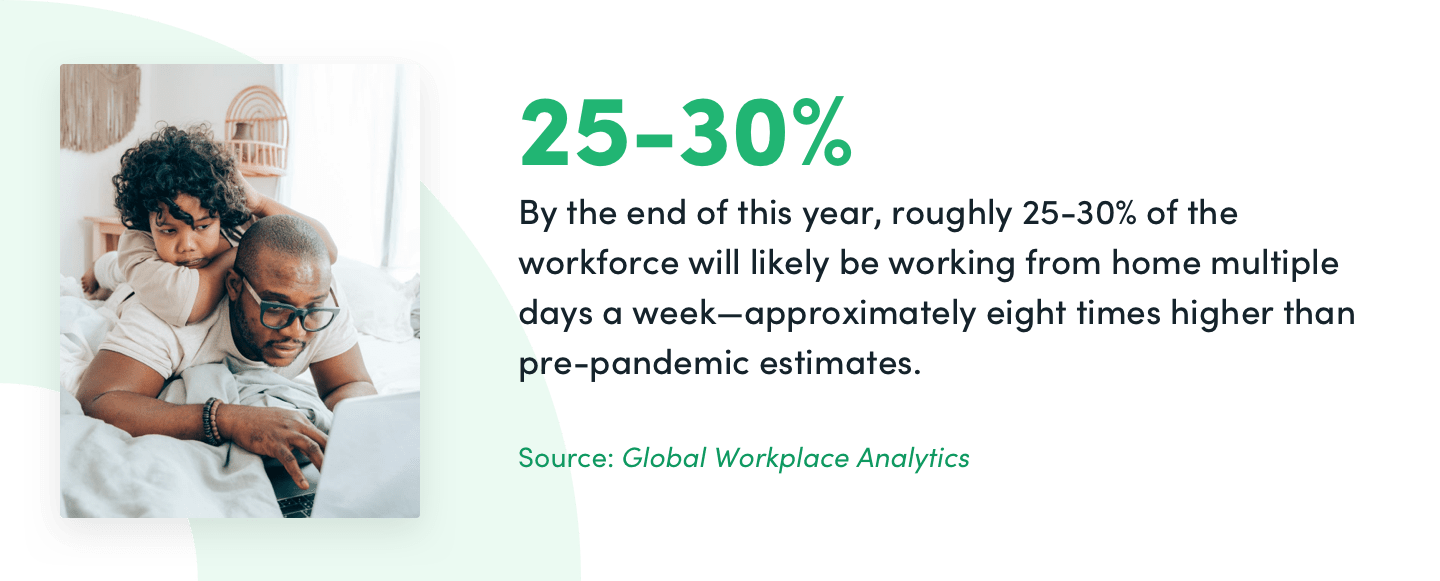After nearly a year of changes that saw millions of employees working from home for the first time, many companies are exploring options for reopening offices. But how many employees will actually be returning to their previous workplaces.
The answer may not be what you'd expect.
A recent Gallagher survey indicates that work-from-home arrangements will continue for 86% of organizations after the pandemic, and that 59% will continue to offer flexible scheduling.
Additional research from WillisTowersWatson shows the number of employees across industries that are expected to be full-time remote is three times higher than 2019 levels. And by the end of this year, roughly 25-30% of the workforce will likely be working from home multiple days a week—approximately eight times higher than pre-pandemic estimates.

From Google to Apple and many more in between, businesses everywhere are extending their work-from-home policies.
The reason? For many organizations, the benefits of remote work are leading many to reimagine how, where, and when work gets done. And not just during times of disruption, but all year long.
Still, there are important variables to consider. While some people are more productive when working from home, others thrive on face-to-face office interactions. And for some roles and responsibilities, remote work may not be feasible long-term.
These and other factors can make it difficult to know if and when remote work is the right choice for a company.
But thankfully, there is a solution. It’s called the hybrid workplace model.
What is the hybrid work environment?
A hybrid work environment involves combining remote work with in-office work. In some instances, a business might have certain individuals report to the office each day while others work from home. In others, employees split their time evenly between working remotely and working on-site. And some companies choose to designate entire teams to one setup or the other. For example: The marketing department might be full-time remote, while members of the product development team work side-by-side in the office each day.
Across each of these approaches, the overarching idea is to find the best fit for each employee—whether that means reporting to an office, working from home, or blending the two on a week-to-week basis.
When Microsoft announced its new plan to support hybrid work from home and office, for instance, the company's chief people officer described it as a way to “offer as much flexibility as possible to support individual work styles while balancing business needs.”
Until recently, some forward-thinking companies had developed the hybrid workplace model as a way to expand their talent base and lower overhead. Then the global pandemic hit, and the idea grew in popularity as organizations looked for ways to move business forward in the midst of potential health risks.
As the researchers at one consulting firm describe it: Hybrid work models, done right, will allow organizations to better recruit talent, achieve innovation, and create value for all stakeholders. By acting boldly now, they can define a future of work that is more flexible, digital, and purposeful.

Did you know? Formstack has followed a hybrid workplace model for nearly a decade! We have office spaces in Fishers, IN and Colorado Springs, CO.

Culture tips for balancing a hybrid home and office environment
Now that we’ve examined how the hybrid model works, the next question is: What does a successful hybrid work environment look like?
Here at Formstack, we’ve been using the hybrid model for nearly a decade. While we do have offices in Indiana and Colorado, our business operates as a remote-first “work from anywhere” company, with employees located around the world.
We use this approach to ensure our employees feel empowered to work from wherever they’re most productive—whether that's in an office or at the kitchen table. More than 60% of our team is completely remote, and the individuals who do report to the office often opt to work from home at various times. Some “locals” even choose to be completely remote.
Of course, finding success in this environment has required a lot of learning along the way.
To help other companies that may be considering a transition to the hybrid workplace model, we’ve pulled together some best practices from members of our own executive team as well others who have shared their experiences. Here’s what they recommend:
Communicate frequently
First, it’s important to be intentional about communication. While employees who report to an office may interact regularly, you’ll need to keep the lines of communication open to those who are working remotely, too.
Keep virtual distractions to a minimum
While communication between in-office and remote employees is critical, be careful not to overdo it. For some employees, one of the many benefits of working remotely is the ability to get into a highly productive “deep work” state. For this reason, it’s important to be intentional about sending Slack messages and scheduling Zoom calls—and recognizing when you could be causing too many distractions and interruptions.
Provide the right technology
If your employees are used to having everyone work in the same office, there may be a transition period as you determine how to manage workflows in a hybrid setting. The more you can streamline daily tasks and responsibilities, the better positioned your teams will be to keep the business moving forward. This is one area where having the right technology in place can be key. Wherever possible, take advantage of no-code tools and automation to ensure operations continue to run smoothly.
Looking for more inspiration? Learn about the Formstack approach to hybrid work, and see how it's played a central role in our company's growth over the years.











